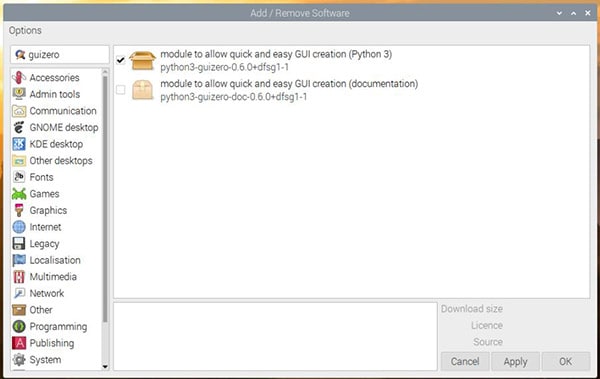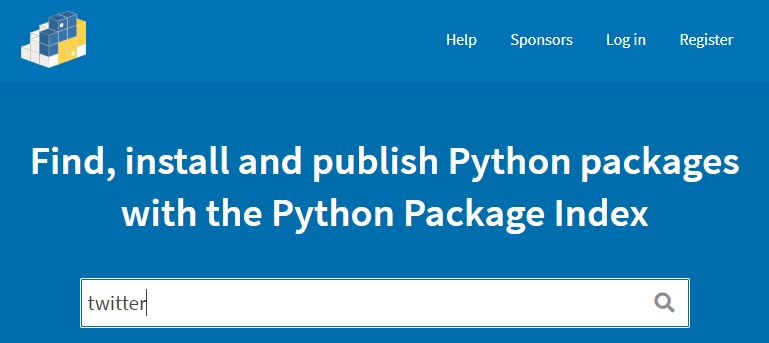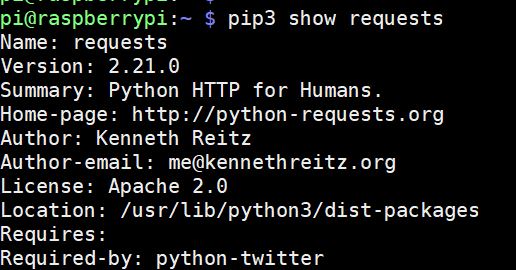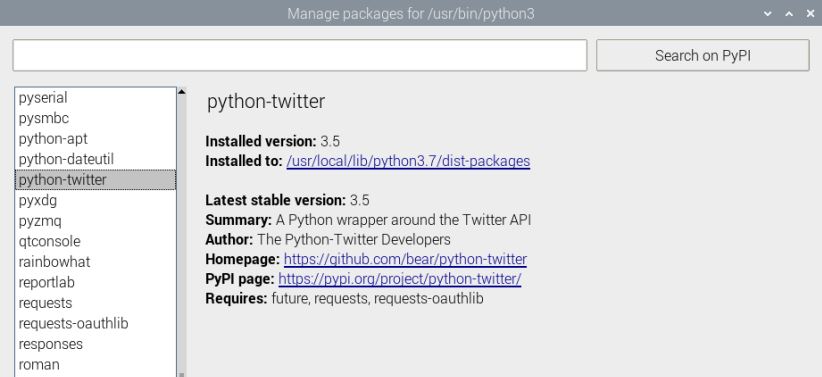How To Install Pip Raspberry Pi
Python is already installed on Raspberry Pi, but using it to create scripts and build various projects will ofttimes require some dependencies named libraries or modules. Even if y'all are good with Python, you might need some aid knowing how to install new packages for Python on Raspberry Pi, which is exactly why I wrote this commodity.
Most of the Python packages for Raspberry Pi are bachelor in the apt repositories. Searching for the library proper name with this tool will be the fastest way to install them. Another tool named "PIP" can also be used for another modules not included in the default repositories.
Either manner, I'll explain everything in this article. I'll first with APT because most modules can be installed with it, and so I'll introduce PIP and will conclude with a few tips on how to manage your Python libraries.
By the way, if you get overwhelmed as before long equally Python is required for a project, I recommend checking out my due east-book "Principal Python on Raspberry Pi". It volition guide you stride-by-step to acquire the essential concepts (and just them) to achieve any projection in the future. Raspberry Pi without Python is similar a motorcar without an engine, you miss all the fun part. Get 10% off by downloading information technology today!
Install Python packages on Raspberry Pi
Grab my cheat sail!
If like me, y'all always mix the languages syntax, download my cheat sheet for Python hither!
The easiest manner to install new Python packages is to use APT (or the graphical version of it: "Add together/Remove Software"). The most mutual Python libraries volition be available in the repositories, often named something like "python3-library".
Observe Python packages on Raspberry Pi
A Python package is created to take reusable code at hand in any projection. For example, a Python library can help with mathematics functions, interaction with an API, or a specific accompaniment. By using this kind of module, you don't need to code the same functions in every new projection.
It's possible to create Python libraries yourself when you work on big projects, merely well-nigh of the fourth dimension, you'll just download and install packages available in the Raspberry Pi Os repositories.
Raspberry Pi Bootcamp
Sale: 10% off today.
Have it to the next level.
I'grand here to help you lot get started on Raspberry Pi.
Acquire all the skills you need in the correct order.
I'll explain how to do this with the "Add / Remove Software" tool or the "apt" control line direct, but the first affair to know is the bundle name yous demand to install.
Recommended Python libraries on Raspberry Pi
The adjacent department works well when you have a specific Python module that you are interested in (and which is available in the repositories), merely possibly you are just looking for ideas and don't know which packages you should install.
Commencement, I recommend starting by reading this article that gives 15 absurd Python project ideas on Raspberry Pi. It's e'er better to kickoff with the goal in listen and build something from there, rather than trying things without clear objectives.
And so, here are a few interesting Python libraries you can use with the method explained below:
- Sense Chapeau: It's the near pop Chapeau for Raspberry Pi, and there is a great module available for it. You can read my tutorial here if you are interested.
- Gui Zippo: The case I take in the next section, it's an like shooting fish in a barrel style to create a basic user interface in Python (forms, buttons, etc.).
- Minecraft Pi: Minecraft is preinstalled on Raspberry Pi. It's a specific version that comes with a Python library to collaborate with the game, which is a cracking way to go started with Python, particularly for kids. I also take a tutorial here.
- OpenCV: Looking for something more advanced? OpenCV is a computer vision library that you lot can use to experiment with machine learning.
Install new Python packages on Raspberry Pi
- On Raspberry Pi OS with Desktop, open the Add together / Remove Software tool.
- Type the library name yous are looking for in the search engine.
Let's say "guizero" as an example. - The tool will bear witness you the corresponding packages:

- Check the corresponding box and click on "Apply" to install it on your system.
- A few seconds later, the package is installed and prepare to use in Python.
Note: At the time of writing, Python ii and iii are installed on Raspberry Pi, brand sure to install the packages for the version yous are using in your script. Read this article if you are not certain.
If yous don't have a desktop environment or prefer to use the command line, here is the equivalent with commands:
- In a final, type the following command to find the exact bundle proper noun:
apt search guizero - Then install the corresponding package:
sudo apt install python3-guizero
Using PIP on Raspberry Pi
Fifty-fifty if the most common Python libraries are available in the Raspberry Pi OS repositories, there are many others that tin can't exist installed this way. Most developers use other methods to share their libraries with the world: PIP.
What is PIP on Raspberry Pi?
PIP is a packet manager for Python packages, it'south preinstalled on Raspberry Pi OS and allow installing libraries that are not available in the default repositories.
It's like a secondary repository, where it's easier to upload and share a Python library, then most developers use information technology to maintain their code. For the end-user (you!), information technology's also easy to employ, as installing PIP packages is not more than complicated than using apt.
You can access the web portal of this tool hither, and use the search engine to find a Python library yous tin can install on Raspberry Pi. I explain everything in the adjacent sections.
Install PIP on Raspberry Pi
PIP is already installed on Raspberry Pi OS by default. If y'all are using another operating system or accept removed information technology, here is how to install information technology:
sudo apt install python3-pip
Same thing as with any Python package, at that place are 2 packages available in the repository: python-pip and python3-pip. Make sure to install and use the version corresponding to your Python installation.
Install Python packages with PIP on Raspberry Pi
Master your Raspberry Pi in 30 days
Sale: 10% off today.
Download the eBook.
Uncover the secrets of the Raspberry Pi in a 30 days claiming.
Learn useful Linux skills and practice multiples projects.
There is a search command bachelor with PIP, merely it seems that information technology isn't available anymore ("PyPI's XMLRPC API is currently disabled due to unmanageable load and volition be deprecated in the near futurity"), so the best way to find packages name is to utilise the website:
- Let's say you are looking for a Python library to use the Twitter API.
- Get to pypi.org and look for Twitter in the search engine:

- So browse the results to detect the one corresponding to your needs. You can sort the results by relevance, trends, and last update.
Effort to avoid libraries that are no longer updated, specially in this case. - On the library page, yous'll generally get some documentation and the control to use to install the parcel.
For example:
pip install python-twitterOn Raspberry Pi, you lot need to use sudo, and also to use pip3 if you run your script with Python 3:
sudo pip3 install python-twitter
If there are any required dependencies, pip will install it automatically on your Raspberry Pi.

Where do PIP packages become in one case installed?
Once downloaded and installed, PIP packages are stored nether /usr/lib/python3/dist-packages. The "testify" control volition brandish the exact location for each packet: "pip3 show requests" for instance.

And I will give you other commands y'all can use to get a improve idea of what is installed on your Raspberry Pi in the adjacent department.
Use Python packages on Raspberry Pi
Get My Cheat Sheet!
Grab your free PDF file with all the commands y'all need to know on Raspberry Pi!
List of the installed Python libraries on Raspberry Pi
At that place are several methods to install Python packages and besides to list those already installed on a Raspberry Pi. The more than complete fashion is to use assist("modules") in the console or a graphical equivalent with Thonny.
List Python modules from the console
- Open the Python console with:
python3 - Type the aid command to display all bachelor modules:
assistance("modules")
It may have some fourth dimension depending on the number of packages installed, and also brandish some errors and various debug data, merely you lot should receive a consummate listing at the end.
Thonny
Thonny is the default Python text editor on Raspberry Pi Os with Desktop. If you are using this version, there is a hidden feature with the list of Python modules available:
- In the main bill of fare, open Thonny Python IDE from the Programming submenu.
- Click on "Switch to regular mode" if y'all are in bones mode, and restart it.
- Then there is a carte on elevation, click on Tools > Manage packages.
- A window like this one volition show up:

- You'll receive the same information as with the previous method, in a more user-friendly way.
By the way, I didn't explain this method in the previous part, but it'south likewise possible to install PIP packages directly in Thonny. Employ the search engine on peak and click on "Install" to add the new Python modules to the listing.
List installed packages with PIP
With PIP, there is a control you tin use to bear witness all installed packages, here information technology is:
pip3 list
You lot'll become a list with all of the installed packages and the corresponding version. It will exist much quicker, but I'm not sure if it really includes everything (those not installed with PIP for example).
Listing installed Debian packages
Master Python on Raspberry Pi
Sale: 10% off today.
Become the eBook.
Practise more than with your Raspberry Pi, learn the useful concepts and have the shortcuts.
You miss half of the fun of using a Raspberry Pi if you don't know anything about Python.
And finally, the last way is to cheque the packages installed with apt, for example:
sudo dpkg -l | grep "python3-"
Yous can use this command on a fresh installation to see what is already included on your system.
Import a Python library in a script
Once the Python library is installed, with apt, PIP, or any other way, it can exist imported into the source lawmaking by adding this line at the beginning of the script:
import <library>For example:
import requests
Then follow the corresponding documentation to utilize all the new functions offered past this module.
For example, my example is a library to create HTTP requests in Python, with a simple code similar this:
import requests
r = requests.get('https://api.github.com/events')
Much simpler than doing it everything yourself from scratch 🙂
Python libraries are actually powerful, so make sure to check if something that can assistance you already exists before spending hours creating your own functions.
Getting started with Python on Raspberry Pi
By the manner, if yous need help getting started with Python, you tin read past tutorial for Python beginners here, and as well bank check my new e-book, "Master Python programming on Raspberry Pi" in the store.
Python is an essential skill to acquire when you lot want to start new projects on Raspberry Pi, the best ones often require Python lawmaking to automate the procedure. For example, nigh Raspberry Pi robot kits are programmed in Python.
Back up u.s.: Bring together the community on Patreon to testify your support, get backside-the-scenes content and other crawly perks!
Raspberry Pi Resources
Not sure where to start?
Understand everything about the Raspberry Pi, stop searching for help all the time, and finally enjoy completing your projects.
Lookout man the Raspberry Pi Bootcamp course now.
Master your Raspberry Pi in xxx days
Don't want the basic stuff only? If you are looking for the all-time tips to become an proficient on Raspberry Pi, this book is for you. Larn useful Linux skills and practise multiple projects with footstep-by-footstep guides.
Download the e-volume.
VIP Community
If y'all just want to hang out with me and show your support, you tin can as well join the Patreon customs. I share behind-the-scenes content there and give you early on access to my content. You lot'll also get a shoutout when you join.
More details here.
Demand help to build something with Python?
Create, understand and improve any Python script for your Raspberry Pi.
Learn the essentials, stride-past-pace, without losing time understanding useless concepts.
Get the e-book now.
You lot tin also find all my recommendations for tools and hardware on this page.
Source: https://raspberrytips.com/install-python-packages-on-raspberry-pi/
Posted by: nethertonwitesse.blogspot.com


0 Response to "How To Install Pip Raspberry Pi"
Post a Comment